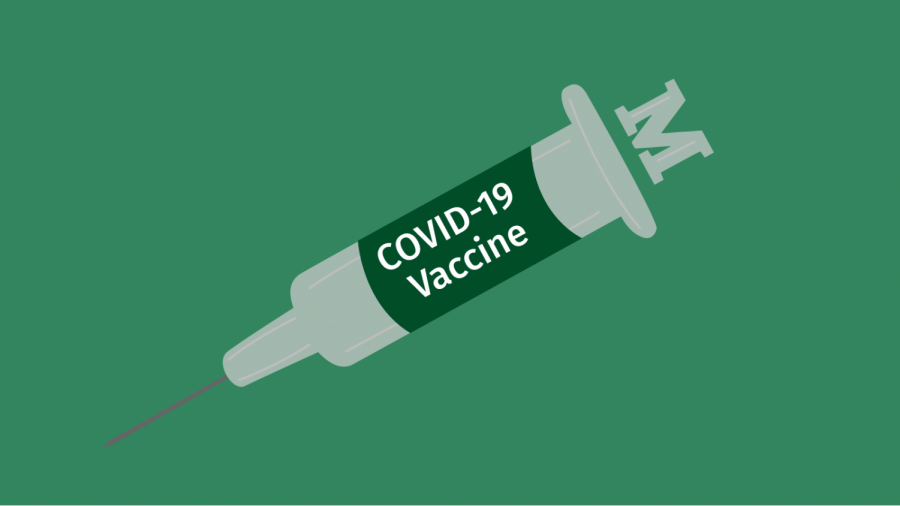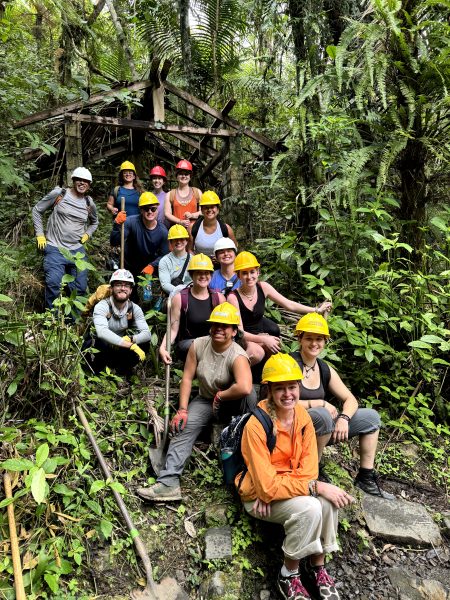COVID-19 vaccines become a topic of discussion on campus
Photo credit/ Autumn Bohner
February 11, 2021
Since COVID-19 vaccines from Pfizer-BioNTech and Moderna were approved for Emergency Use Authorization (EUA) by the U.S. Food and Drug Administration (FDA) they have been the main topic of conversation across the country, including at Marywood.
To help distribute the vaccines, the Pennsylvania Department of Health has created a four-phase rollout plan. Pennsylvania is currently in the 1A phase which covers the following individuals:
- Long-term care facility residents
- Health care personnel
- People not directly involved in patient care but may be exposed to infectious material that can transmit disease
- People ages 65 and older
- People ages 16-64 with high-risk conditions
From discussions on hesitancy and distribution to personal experiences receiving, the campus community is now facing the next stage of the pandemic. All the while the university is working to acquire enough vaccines to host a vaccine clinic.
Marywood to try to host a vaccine clinic
Director of Student Health Services Maura Smith explained that the office is collaborating with the university administration and Physician Assistant Program Chair Abigail Davis to secure enough vaccines to hold a clinic for faculty and staff when Pennsylvania enters the 1B phase. As of now, they have not received an answer or commitment.
“The healthcare networks that we’re working with have to first secure enough vaccines to meet our demand,” said Smith. “We’ve been working closely with a few healthcare providers and they don’t want to over commit and under deliver.”
To establish the needed number of vaccines, Student Health Services has sent emails to faculty and staff asking if they would be interested in receiving the vaccine if they meet the case criteria. Smith explained that the number of interested faculty and staff fluctuates as faculty and staff acquire vaccines from other places.
Student Health Services has also reached out to larger pharmacies like Rite Aid and CVS to secure on-campus vaccinations for students when Pennsylvania enters phase 2 of the rollout plan. As of now, there have been no answers or commitments.
Students begin to receive the vaccine from other places
Some Marywood students have already been able to receive the vaccines through other means.
Junior Nursing major Jennifer Kurzweil works as a patient care associate in a respiratory unit-turned-COVID-19 unit. Through her work, she was able to receive both doses of the Pfizer vaccine. Kurzweil said she felt some side effects after receiving the vaccine but overall felt hopeful.
“After my first vaccine, I had some chills and muscle pain, as well as a headache,” said Kurzweil. “After receiving my second vaccine I just had a headache.”
Sophomore Vocal Performance major Sarah Ounsworth was also able to receive the Pfizer vaccine through her work in the healthcare field. As of publication, Ounsworth has only received the first dose of the vaccine. During this experience, she experienced symptoms that lasted for about 12 hours.
“A few minutes after the vaccine was administered, I was fatigued and that lasted until the next day,” said Ounsworth. “I would also include loss of appetite and chills as minor symptoms I had for a few hours after the vaccine was administered.”
Senior History/Pre-Law major Zachary Penzone was able to receive the Moderna vaccine due to having a high-risk condition. Penzone said that after receiving his first dose he had no issues or concerns with the vaccine.
“After I got the vaccine, I was excited and hopeful about the future,” said Penzone. “The next day I was tired and the injection site hurt a little but no more than any other shot.”
The rollout process sparks frustrations
Even as people begin to receive the vaccine, frustration has grown over the rollout plan. Smith explained that she believes the issue of supply and demand was not instituted well with Pennsylvania’s plan.
“When they expanded the 1A group I think they expanded it in hopes that it would interest more people in getting the vaccine but clearly they were not ready for how many people would be interested in getting the vaccine,” said Smith.
Kurzweil said she believes the rollout plan may continue to get worse.
“I think that the demand for the vaccine will continue to be higher than the supply for quite some time,” said Kurzweil. “At some point, I hope that there will not be as much of an issue as to acquiring the vaccine and that companies will be able to provide more vaccines quicker.”
Smith also noted that another issue with the rollout plan is that distribution is not at an even playing field.
“It seems like larger companies are receiving much larger quantities than family pharmacies or even the chain pharmacies which are what people have easier access to,” said Smith.
Vaccine hesitancy is still present
Although people are working to try to get the vaccine, others are still on the fence about receiving it. In fact, according to a poll by the Associated Press-NORC Center for Public Affairs Research a third of U.S. adults are still skeptical about the vaccines.
Smith acknowledges that some feel hesitant over the false notion that the rollout was too quick or that there weren’t enough investigations. Smith explained that when there were outbreaks of SARS and MERS, the United States and other countries were already working on a vaccine for SARS variants. When those viruses did not turn into pandemics, the research was halted and so was the funding.
When SARS-COVID-2, which causes COVID-19, burst onto the scene, a lot of funding was put back into research, and vaccine companies were able to pick up where they left off a few years ago.
Smith also said some people may be hesitant to get the vaccine due to the unknown or concerns over the length of immunity. Additionally, they may be concerned about side effects. For those who are on the fence about getting the vaccine, Smith advises them to speak with their primary care physician in order to arrive at a decision that is best for the person’s well-being.
Contact the writer: [email protected]
Twitter: @BrianaRyanTWW














